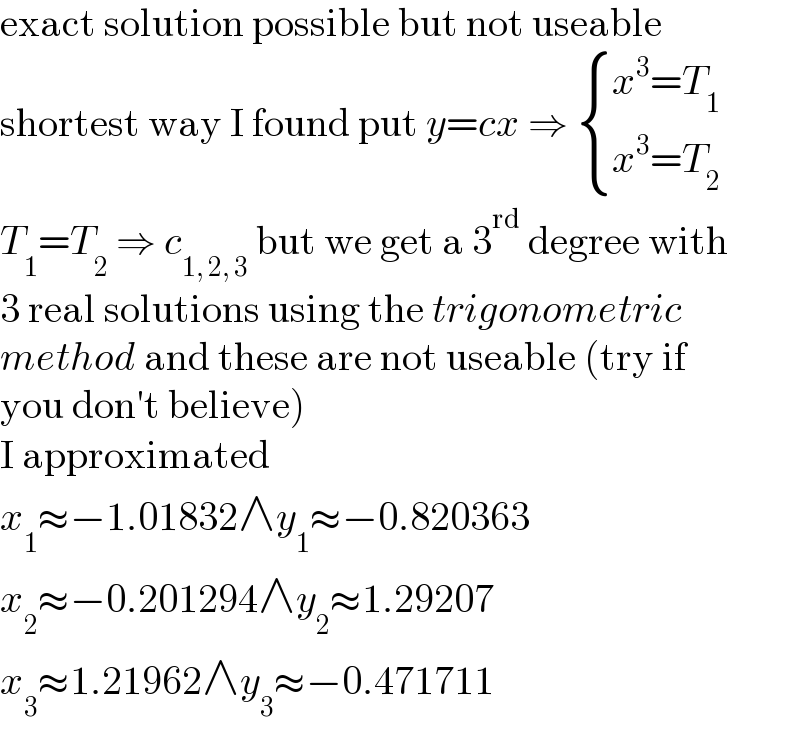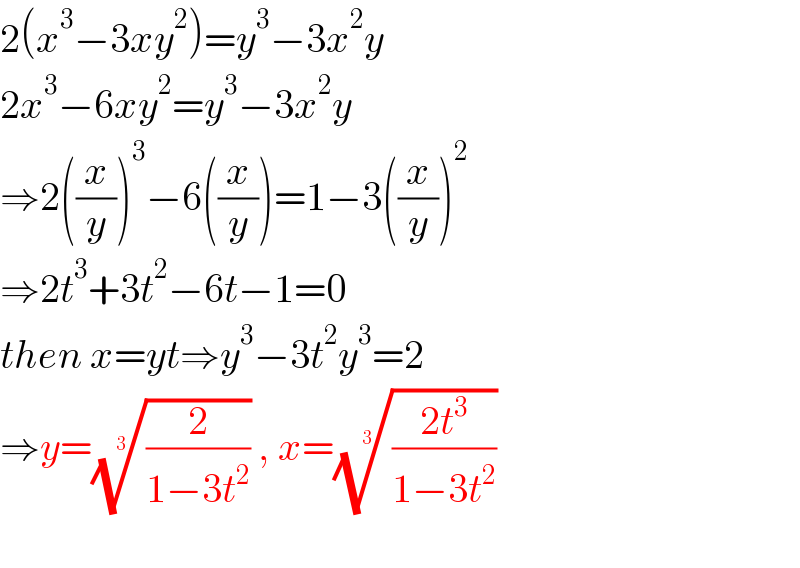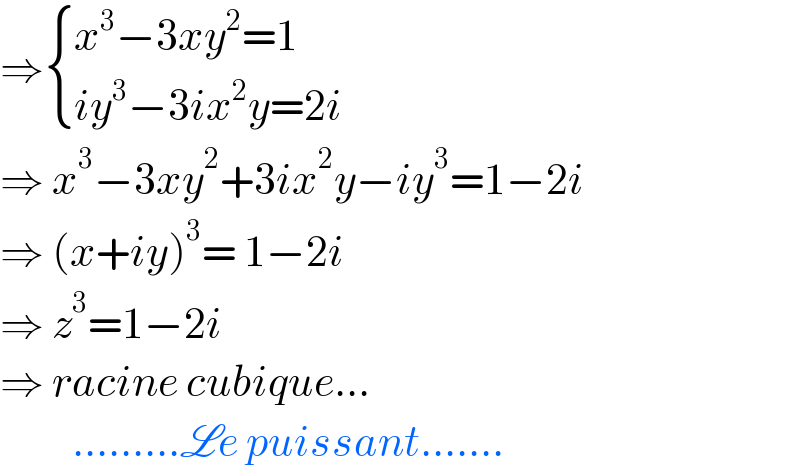
Question Number 173706 by infinityaction last updated on 16/Jul/22

Commented by Frix last updated on 16/Jul/22

$$\mathrm{exact}\:\mathrm{solution}\:\mathrm{possible}\:\mathrm{but}\:\mathrm{not}\:\mathrm{useable} \\ $$$$\mathrm{shortest}\:\mathrm{way}\:\mathrm{I}\:\mathrm{found}\:\mathrm{put}\:{y}={cx}\:\Rightarrow\:\begin{cases}{{x}^{\mathrm{3}} ={T}_{\mathrm{1}} }\\{{x}^{\mathrm{3}} ={T}_{\mathrm{2}} }\end{cases} \\ $$$${T}_{\mathrm{1}} ={T}_{\mathrm{2}} \:\Rightarrow\:{c}_{\mathrm{1},\:\mathrm{2},\:\mathrm{3}} \:\mathrm{but}\:\mathrm{we}\:\mathrm{get}\:\mathrm{a}\:\mathrm{3}^{\mathrm{rd}} \:\mathrm{degree}\:\mathrm{with} \\ $$$$\mathrm{3}\:\mathrm{real}\:\mathrm{solutions}\:\mathrm{using}\:\mathrm{the}\:{trigonometric} \\ $$$${method}\:\mathrm{and}\:\mathrm{these}\:\mathrm{are}\:\mathrm{not}\:\mathrm{useable}\:\left(\mathrm{try}\:\mathrm{if}\right. \\ $$$$\left.\mathrm{you}\:\mathrm{don}'\mathrm{t}\:\mathrm{believe}\right) \\ $$$$\mathrm{I}\:\mathrm{approximated} \\ $$$${x}_{\mathrm{1}} \approx−\mathrm{1}.\mathrm{01832}\wedge{y}_{\mathrm{1}} \approx−\mathrm{0}.\mathrm{820363} \\ $$$${x}_{\mathrm{2}} \approx−\mathrm{0}.\mathrm{201294}\wedge{y}_{\mathrm{2}} \approx\mathrm{1}.\mathrm{29207} \\ $$$${x}_{\mathrm{3}} \approx\mathrm{1}.\mathrm{21962}\wedge{y}_{\mathrm{3}} \approx−\mathrm{0}.\mathrm{471711} \\ $$
Answered by aleks041103 last updated on 16/Jul/22

$$\mathrm{2}\left({x}^{\mathrm{3}} −\mathrm{3}{xy}^{\mathrm{2}} \right)={y}^{\mathrm{3}} −\mathrm{3}{x}^{\mathrm{2}} {y} \\ $$$$\mathrm{2}{x}^{\mathrm{3}} −\mathrm{6}{xy}^{\mathrm{2}} ={y}^{\mathrm{3}} −\mathrm{3}{x}^{\mathrm{2}} {y} \\ $$$$\Rightarrow\mathrm{2}\left(\frac{{x}}{{y}}\right)^{\mathrm{3}} −\mathrm{6}\left(\frac{{x}}{{y}}\right)=\mathrm{1}−\mathrm{3}\left(\frac{{x}}{{y}}\right)^{\mathrm{2}} \\ $$$$\Rightarrow\mathrm{2}{t}^{\mathrm{3}} +\mathrm{3}{t}^{\mathrm{2}} −\mathrm{6}{t}−\mathrm{1}=\mathrm{0} \\ $$$${then}\:{x}={yt}\Rightarrow{y}^{\mathrm{3}} −\mathrm{3}{t}^{\mathrm{2}} {y}^{\mathrm{3}} =\mathrm{2} \\ $$$$\Rightarrow{y}=\sqrt[{\mathrm{3}}]{\frac{\mathrm{2}}{\mathrm{1}−\mathrm{3}{t}^{\mathrm{2}} }}\:,\:{x}=\sqrt[{\mathrm{3}}]{\frac{\mathrm{2}{t}^{\mathrm{3}} }{\mathrm{1}−\mathrm{3}{t}^{\mathrm{2}} }} \\ $$$$ \\ $$
Commented by aleks041103 last updated on 16/Jul/22

$${for}\:{t}\:{we}\:{don}'{t}\:{have}\:{exact}\:{sols} \\ $$$${t}\approx−\mathrm{2}.\mathrm{586};−\mathrm{0}.\mathrm{156};\mathrm{1}.\mathrm{241} \\ $$$$\Rightarrow \\ $$$$\left({x},{y}\right)=\left(\mathrm{1}.\mathrm{22},\mathrm{0}.\mathrm{472}\right);\left(−\mathrm{0}.\mathrm{201},\mathrm{1}.\mathrm{292}\right);\left(−\mathrm{1}.\mathrm{018},−\mathrm{0}.\mathrm{820}\right) \\ $$
Answered by puissant last updated on 17/Jul/22

$$\Rightarrow\begin{cases}{{x}^{\mathrm{3}} −\mathrm{3}{xy}^{\mathrm{2}} =\mathrm{1}}\\{{iy}^{\mathrm{3}} −\mathrm{3}{ix}^{\mathrm{2}} {y}=\mathrm{2}{i}}\end{cases} \\ $$$$\Rightarrow\:{x}^{\mathrm{3}} −\mathrm{3}{xy}^{\mathrm{2}} +\mathrm{3}{ix}^{\mathrm{2}} {y}−{iy}^{\mathrm{3}} =\mathrm{1}−\mathrm{2}{i} \\ $$$$\Rightarrow\:\left({x}+{iy}\right)^{\mathrm{3}} =\:\mathrm{1}−\mathrm{2}{i} \\ $$$$\Rightarrow\:{z}^{\mathrm{3}} =\mathrm{1}−\mathrm{2}{i}\: \\ $$$$\Rightarrow\:{racine}\:{cubique}... \\ $$$$\:\:\:\:\:\:\:\:\:.........\mathscr{L}{e}\:{puissant}....... \\ $$
